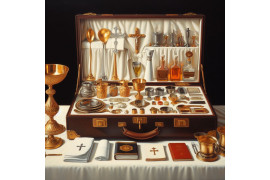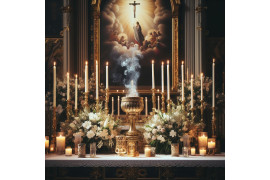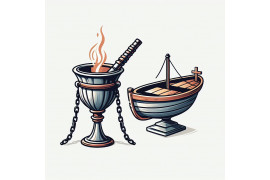Pyxes have a rich history dating back to early Christian practices. These containers, used to hold the Eucharist, are known as pyx from the Greek word "pyxis," meaning box or container. While pyxes today are commonly associated with gold-plated designs, in biblical times they were likely made of wood or clay rather than metal. Regardless of the material, pyxes symbolize the sacredness and reverence associated with the Eucharist.
The use of a pyx allows for the safe and respectful transport of consecrated hosts outside liturgical services. Whether it is a brass pyx, a gold pyx, or any other type, these small pocket-sized cases serve as a tangible reminder of the presence of Christ in the Eucharist. Understanding the historical significance and symbolism behind a pyx can deepen one's appreciation for this cherished religious object.
Must a Pyx be Made of Metal?
Traditionally, pyxes were crafted from precious metals like gold or silver. However, there are no strict requirements stating that a pyx must be made of metal. In fact, some modern pyxes are created using alternative materials such as glass or ceramic. The choice of material for a pyx ultimately depends on personal preference and practicality.
Traditional Materials: Gold and Silver
Historically, pyxes have been associated with religious rituals and ceremonies. As such, they were often made from valuable metals like gold or silver to reflect their significance. These materials not only added beauty to the pyx but also symbolized the importance and reverence of the sacred objects contained within.
Alternative Materials: Glass and Ceramic
In recent times, there has been an emergence of pyxes made from alternative materials such as glass or ceramic. These materials offer unique advantages in terms of design flexibility and affordability. Glass pyxes, for example, can be intricately etched or stained to create stunning visual effects. Ceramic pyxes provide durability and a wide range of color options.
Personal Preference and Practicality
The choice between metal, glass, ceramic, or any other material for a pyx ultimately comes down to personal preference and practicality. Some individuals may prefer the traditional elegance of a gold or silver pyx due to its historical significance and aesthetic appeal. Others may opt for alternative materials that better suit their style or budget.
When selecting a material for a pyx, it is important to consider factors such as durability, ease of cleaning, and portability. For instance:
-
Metal pyxes are typically more durable than glass or ceramic ones.
-
Glass pyxes may require extra care due to their fragility but offer exquisite visual qualities.
-
Ceramic pyxes strike a balance between durability and aesthetics.
Ultimately, the chosen material should align with the intended use of the pyx while also meeting the individual's preferences and needs.
Exploring Different Materials Used for Pyxes
Metal pyxes are a popular choice due to their durability and ability to be intricately designed. These pyxes, often made of polished brass or pewter, can withstand regular use and handling without losing their appeal. They can be adorned with engravings or embellishments, making them visually appealing and unique. Metal pyxes provide a sturdy vessel for holding the consecrated host.
Glass pyxes offer the advantage of visibility, allowing the consecrated host to be seen without opening the container. This is particularly useful during liturgical ceremonies where transparency is desired. Glass pyxes come in various shapes and sizes, ranging from simple cylindrical containers to more elaborate designs. The transparent nature of glass allows for easy identification of the contents inside.
Ceramic pyxes provide versatility in terms of shape, size, and design possibilities. They can be molded into different forms and customized as per individual preferences. Ceramic pyxes are often handcrafted by skilled artisans who create intricate patterns or paint designs on them. This allows for a wide range of artistic expressions and personalization options.
Wooden pyxes evoke a sense of natural beauty and simplicity. They are often crafted from high-quality wood, such as oak or walnut, which adds an elegant touch to the overall design. Wooden pyxes can be engraved or carved with religious symbols or motifs, enhancing their spiritual significance. The warm tones and natural grains of wood make these pyxes aesthetically pleasing.
While gold-plated pyxes may not necessarily have to be made entirely of gold, they do feature a layering of gold onto another material like brass or pewter. Gold plating provides an exquisite appearance while still maintaining durability and practicality. These pyxes offer a balance between elegance and affordability.
Other materials used for creating pyxes include leather and ivory. Leather burse-style boxes are commonly used to hold small-sized metal or glass pyxes securely. Ivory, although less common due to ethical concerns, has historically been used for crafting intricate pyxes.
Understanding the Episcopal Church's Requirements for Pyxes
In the Episcopal Church, there are no specific mandates regarding the material or appearance of a pyx. However, it is essential to understand that the vessel used should reflect reverence and respect for the sacrament it holds.
While there may not be strict regulations, individual clergy members may have preferences or guidelines within their respective dioceses regarding pyx usage. These guidelines could include suggestions on materials, design elements, or even specific instructions on how to handle and care for the pyx.
It is important to remember that adherence to church teachings on the Eucharist takes precedence over specific regulations about pyxes. The focus should always be on understanding and honoring the significance of this sacred sacrament.
No Mandated Material or Appearance Requirements
The Episcopal Church does not enforce any particular requirements. This means that clergy members have some flexibility in choosing a pyx that aligns with their personal preferences and practices.
Reverence and Respect for the Sacrament
Although there are no mandated requirements, it is crucial to select a pyx that reflects reverence and respect for the sacrament of Holy Communion. The vessel should be chosen thoughtfully, considering its purpose as a container for consecrated bread used during worship services.
Individual Preferences and Diocesan Guidelines
While there may not be overarching rules set by the Episcopal Church as a whole, individual clergy members may have their own preferences or guidelines within their respective dioceses. These preferences could stem from traditions within a particular congregation or practical considerations based on local customs.
For example:
-
A diocese might encourage using gold-plated pyxes due to their association with precious metals often associated with religious ceremonies.
-
Another diocese might prefer simpler materials like silver or pewter for practical reasons such as ease of cleaning and maintenance.
Clergy members can consult their bishops or fellow clergy to understand any specific guidelines or recommendations in their diocese.
Adherence to Church Teachings
Ultimately, the most important aspect of using a pyx is not the material it is made of or its appearance, but rather adherence to church teachings on the Eucharist. The focus should be on understanding and respecting the significance of the sacrament and approaching it with reverence.
Comparing Metal Pyxes to Non-Metal Alternatives
Metal pyxes have long been regarded as a traditional and timeless choice, also known as the Eucharist. The use of precious metals like gold, silver, or brass adds an air of reverence and symbolism to these containers used in religious ceremonies. However, there are also non-metal alternatives available that offer unique characteristics worth considering.
One advantage of metal pyxes is their aesthetic appeal. The gleam of gold or silver can create a sense of grandeur and solemnity during religious rituals. These metal containers often feature intricate designs such as crosses or enameled images of lambs, further adding to their visual allure.
On the other hand, non-metal alternatives provide interesting features that may suit different preferences. For example, transparent pyxes made from materials like glass or acrylic allow for a clear view of the consecrated bread inside. This transparency can be symbolic, representing the sacred nature of the Eucharist.
Non-metal options tend to be lightweight compared to their metal counterparts. This makes them easier to handle and transport, especially for individuals who need to carry the pyx during home visits or hospital visits for communion services.
Maintenance and cleaning requirements are another factor to consider when choosing between metal and non-metal pyxes. Metal containers may require more attention in terms of polishing and upkeep due to their susceptibility to tarnishing over time. Non-metal alternatives often only need regular washing with mild soap and water.
Ultimately, the decision between a metal or non-metal pyx depends on personal preference, practicality, and desired symbolism. Some individuals may prioritize tradition and opt for a classic gold or silver container with intricate cross designs. Others may prefer modern alternatives that embrace transparency or artistic designs.
It's important to note that while metal pyxes are commonly associated with religious ceremonies held within churches or at altars, non-metal options can also be suitable for personal use at home or for smaller gatherings. The capacity of a pyx is typically small, measuring around a few centimeters in diameter, allowing for the transport of a limited amount of consecrated bread.
The Symbolism of a Pyx in Episcopal Worship
A pyx holds great significance in the Episcopal Church, as it symbolizes the sacredness of the Eucharist and serves as a vessel for carrying the consecrated host. During Holy Communion, the priest places a consecrated host, representing the body of Christ, inside the pyx before distributing it to those unable to attend the service. This practice reinforces the belief in Christ's real presence among the faithful.
Symbolizing Christ's Presence
The use of a pyx during Holy Communion is deeply rooted in symbolism. It represents Christ's presence among believers and serves as a tangible reminder of His sacrifice. When a communicant receives the host from a pyx, they are receiving not just bread, but also acknowledging their connection to Jesus and His teachings.
Conveying Symbolic Meanings
The design and material of a pyx can convey different symbolic meanings within the context of worship. While traditionally made of gold or silver, modern-day pyxes may also be crafted from pewter or other metals. Each material choice carries its own significance.
-
Gold: A pyx made of gold signifies its preciousness and links it to royalty or divinity.
-
Silver: Silver symbolizes purity and reflects light, representing Christ as "the light of the world."
-
Pewter: A pewter motif may be more accessible for congregations with limited resources, while still serving its purpose effectively.
Reverence for Sacred Vessels
Using a pyx with reverence is essential in upholding its symbolism and reinforcing beliefs surrounding Holy Communion. Episcopal's priests are entrusted with caring for sacred vessels such as pyxes, ensuring they are kept clean and handled respectfully. This care demonstrates reverence for both what the vessels contain—the blessed sacrament—and what they represent—the divine presence.
Incorporating Symbolic Elements
Many pyxes feature decorative elements that further enhance their symbolism within the Episcopal tradition. Some pyxes may have a medallion with the Chi Rho symbol, which represents Christ. Others may be adorned with intricate designs or engravings that depict scenes from the Bible or represent important theological concepts.
Appreciating the Importance and Diversity of Pyxes in the Episcopal Church
In conclusion, pyxes play a significant role in the Episcopal Church, serving as vessels to hold consecrated hosts for distribution during Holy Communion. While traditionally made of gold, it is not a requirement for a pyx to be made of this precious metal. The Episcopal Church allows for various materials to be used, as long as they are suitable for carrying the sacred elements.
Understanding the diversity of materials used for pyxes allows individuals to choose options that align with their personal preferences and budget. Whether it's a traditional gold pyx or a modern alternative made from non-metal materials like ceramic or wood, each choice can carry its own symbolism and significance within the context of worship.
For those seeking further information on pyxes in the Episcopal Church, it is recommended to consult local clergy or visit reputable religious supply stores specializing in liturgical items. Exploring different options will provide a more in-depth understanding of the symbolism behind these vessels and help individuals make informed decisions when selecting a pyx that suits their needs.
FAQs:
What are some common materials used for making pyxes?
Pyxes can be made from various materials such as gold, silver, brass, pewter, ceramic, wood, or even glass. Each material carries its own aesthetic appeal and symbolic significance.
Are there any specific requirements regarding the size of a pyx?
The size of a pyx may vary depending on personal preference and practicality. However, it should be large enough to accommodate consecrated hosts while remaining portable and easy to handle during worship services.
Can I personalize or customize my pyx?
Yes, many religious supply stores offer customization options for pyxes. This may include engraving initials or symbols on the exterior surface. However, it is important to ensure that any customizations are respectful and appropriate within the context of religious worship.
How do I properly care for a pyx?
To maintain the sacredness of the pyx, it is crucial to keep it clean and free from any contaminants. Regularly washing with mild soap and water, followed by thorough drying, is generally recommended. Storing the pyx in a protective pouch or case can help prevent damage.
Can I use a non-metal pyx during Holy Communion?
Yes, as long as the material used is appropriate for carrying consecrated hosts and meets the guidelines set forth by the Episcopal Church. Non-metal pyxes made from materials like ceramic or wood are acceptable alternatives to traditional metal pyxes.



